My son and his fiancée wanted to give wildflower seed packets as favors for their wedding. I wanted to make sure that all the seeds were native species.

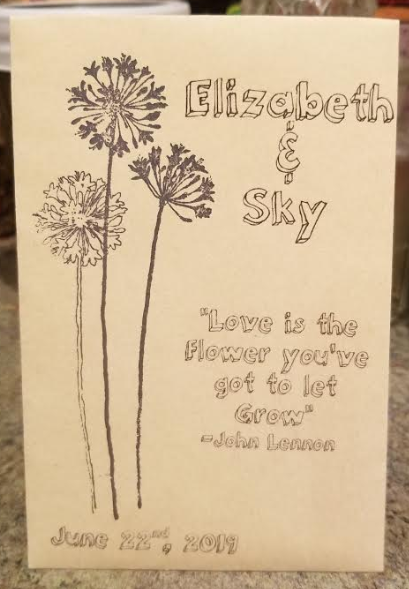
The problem with nearly all commercially available wildflower seed blends is that they usually do not contain native species, even when it says that it is formulated for a specific region. In fact many have been shown to contain noxious weeds!
Native wildflowers evolved along side native insect pollinators and hummingbirds and are great for attracting them to your yard!
I set about purchasing seeds to make our own custom blend. (It is not scientific or tested, but includes species that I was able to purchase in some quantity at a reasonable price.
Planting Guide:
- Some of these wildflower seeds need a cold-winter stratification, so it is better to plant in the fall. (Although you could save some seed to plant in spring, too; some may be better sown in spring.)
- For best results, prepare a new planting area.
- Clear the area of weeds.
- You can till in some clean, well-draining soil, but it is better if it is not a rich organic garden blend; native prairie plants often compete better on less fertile soil.
- Rake out the soil to prepare for planting.
- Scatter the seeds on the surface of the soil. Mixing the seed with some sand first may be helpful to spread seeds evenly and space them out.
- Water the seeds after sowing. They will need to be watered whenever there has not been any measurable rainfall…at least until plants are established. With our unpredictable weather, it is always a good idea to watch for dryness and signs of stress…
- The biggest challenge is always weeding. Since you may not recognize what is a weed and what is a wildflower, you should wait until you can tell for sure what is a weed before pulling it!
The seed list:
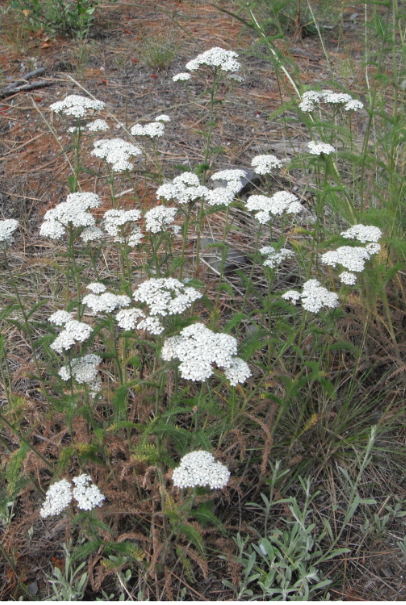
Common Yarrow Achillea millefolium 12-24″ It has white flowers and fern-like foliage. Yarrow is common throughout much of the northern hemisphere in Asia, Europe, and North America. It is long been used as a medicinal herb. The genus name Achillea is derived from Achilles, who reportedly carried it with his army to treat battle wounds. It is great for a butterfly garden. It can be mowed and is often a component of eco-lawns.

Nodding Onion Allium cernuum 8-18″ It has attractive nodding pink flowers and grasslike, oniony foliage. Like most allium species, it can be used in moderate amounts as flavoring. They are pollinated by bees and often self-sow.
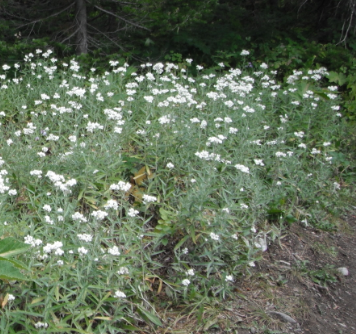
Pearly Everlasting Anaphalis margaritacea 8-40″ It has small, white, strawflower-like flowers that keep well in a dried flower bouquet. The foliage is grayish. It does well in sunny sites. The leaves are host to the caterpillars of the American Painted Lady Butterfly.
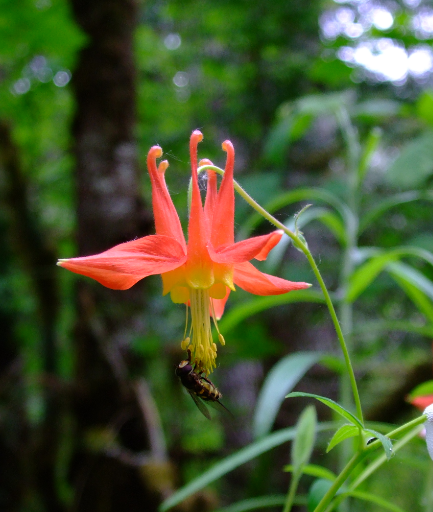
Western Columbine Aquilegia formosa
8-48 It has Red or orange sepals and yellow petals. “Aquila” is Latin for Eagle, but it appears that Aquilegia really comes from the Latin word, Aquilegus, which means water-collecting. “Formosa” means beautiful. “Columbine” is from Columba, Latin for dove (from the resemblance of the flower to a cluster of five doves). Hummingbirds, butterflies, bees and even children enjoy Columbine’s sweet nectar!
Showy Milkweed Asclepias speciosus 18-50″ It has light pink to purple flowers fading to yellow. Milkweed plants are the only type of plant on which Monarch butterflies lay their eggs. Their larvae will feed on the plant ingesting chemicals from that make the Monarchs distasteful to most predators.
Nodding Bur Marigold Bidens cernua 4-40″ This flower is named for the graceful droop of the yellow daisy-like flowers. The seeds have sticky barbs which stick to clothes or fur. Other names include Beggarsticks or Stick tights. The seeds are a favorite food of ducks, sparrows and finches.
Yellow Marsh Marigold Caltha palustris 8-12″ Marsh Marigolds are are also known as Cowlips, Maybuds or Kingcups. The yellow flowers are reminiscent of Buttercups. Caltha is derived from ancient Greek meaning Goblet; palustis is from Latin meaning “of the marsh.”
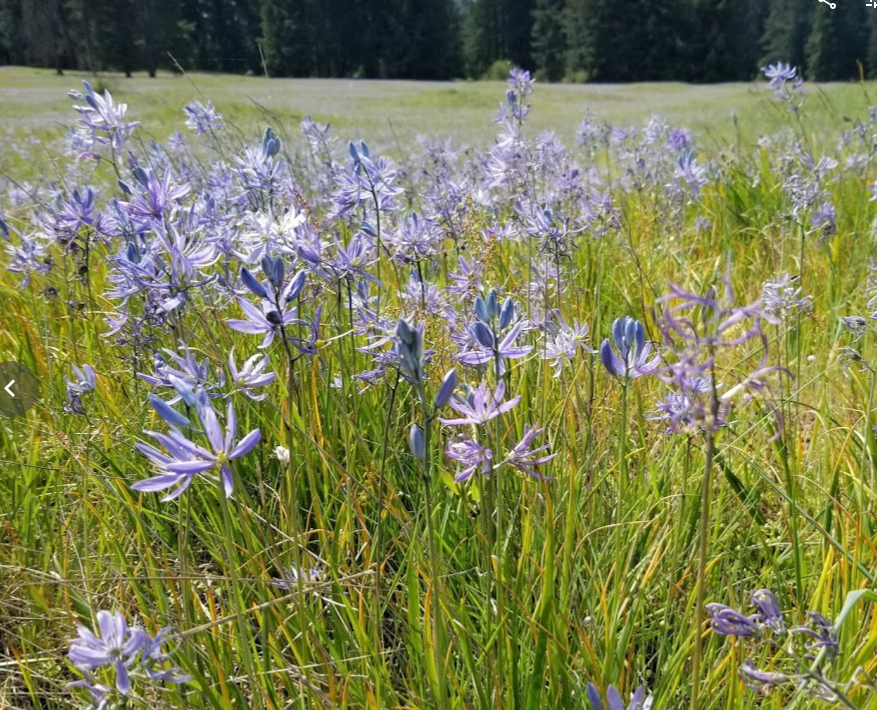
Common Camas Camassia quamash 6-26″ William Clark wrote in his journals “…the quawmash is now in blume at a Short distance it resemhles a lake of fine clear water, So complete is this deseption that on first Sight I could have Sworn it was water. …” Camas bulbs were the most traded food by Northwest natives after dried salmon. The bulbs were traditionally cooked in pits. Cooking is necessary for maximum conversion of the inulin in to fructose to reduce intestinal distress (gas!).
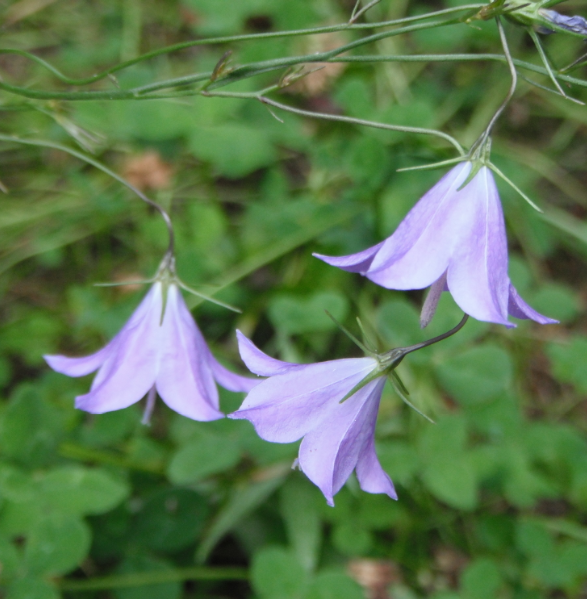
Harebell Campanula rotundifolia 4-20″ Also known as Bluebells of Scotland, this plant has the typical blue bell-shaped flowers of campanulas. It is found throughout much of North America and Europe. The basal leaves are often round, the meaning of rotundifolia, but the leaves further up are more linear
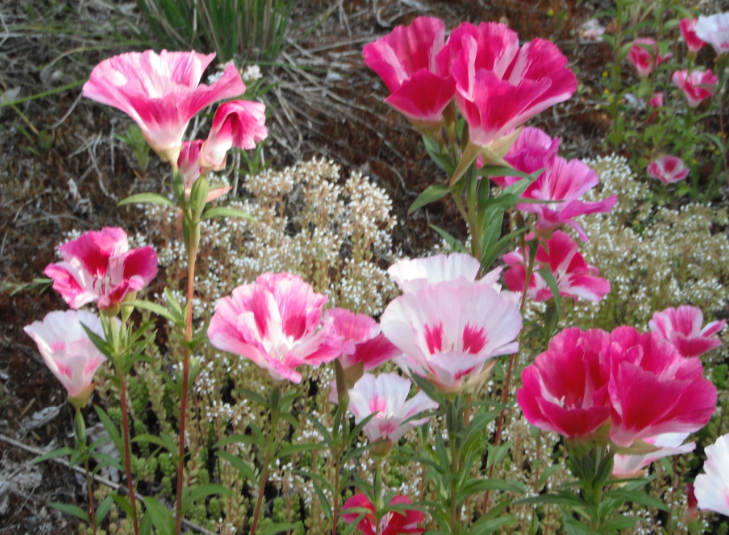
Farewell-to-Spring Clarkia amoena 6-24″ This beautiful annual flower with it shades of pink and white was named in honor of William Clark. The fruit is a dry capsule, which splits open when mature to release the numerous seeds; it often will continue to self-sow for several years. Amoena means “charming.”
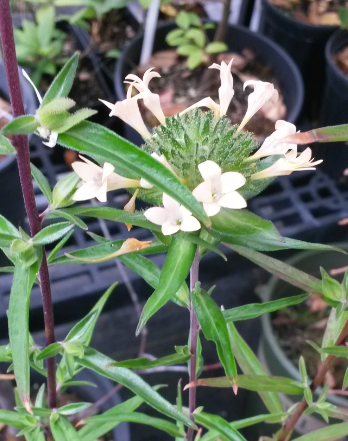
Large-flowered Collomia Collomia grandiflora 4-36″ This peachy flowered annual was first described by explorer David Douglas. The genus name “Collomia” means glue, referring to the sticky seeds.
Pretty Shooting Star Dodecatheon pulchellum
6-20″ Also known as Dark-throat or Few-flowered Shooting Star. This wildflower has attractive “upside down” purple/magenta flowers above a short yellow tube. Dodecatheon means “12 gods.” pulchellum means “pretty.”
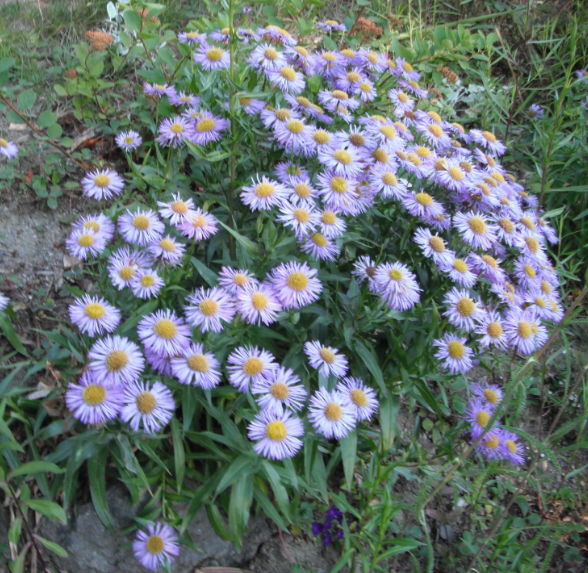
Showy Fleabane Erigeron speciosus 6-30″ This is a daisy-like flower with numerous lavender-blue ray flowers with a yellow center. Erigeron means “old man,” referring to the white hair on the seed heads. The dried flowers were used in Medieval times for repelling fleas.
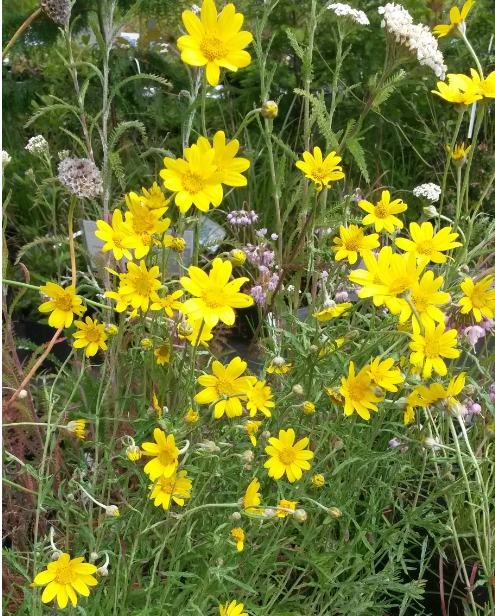
Oregon Sunshine Eriophyllum lanatum 4-40″ This has bright daisy-like yellow flowers and gray leaves. It is also called Wooly Eriophyllum. Both the genus and species names refer to the wooly hairs on the leaves, which help to provide some drought-tolerance.
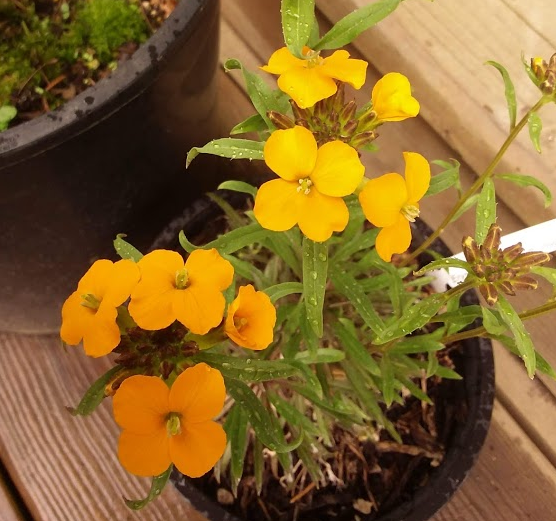
Western Wallflower Erysimum capitatum 24-48″ Belonging in the mustard family, its fragrant flowers are most typically bright golden, yellow, or tangerine-colored. A European relative earned the name wallflower for its habit of growing on stone and masonry fences and walls. Wallflowers are important sources of food for wildlife, including the caterpillars of a number of butterfly and moth species.
Ballerina California Poppy Eschscholzia californica ‘Ballerina’ 8-14″ Not strictly native, although the species does occur in several Washington and Oregon counties, as well as California. This selected mix has filly crepe-like flowers in mixed colors of pink, yellow, cream, orange, and red. I love the colors, plus the name has significance, since my future daughter-in-law has been dancing ballet since she was small.
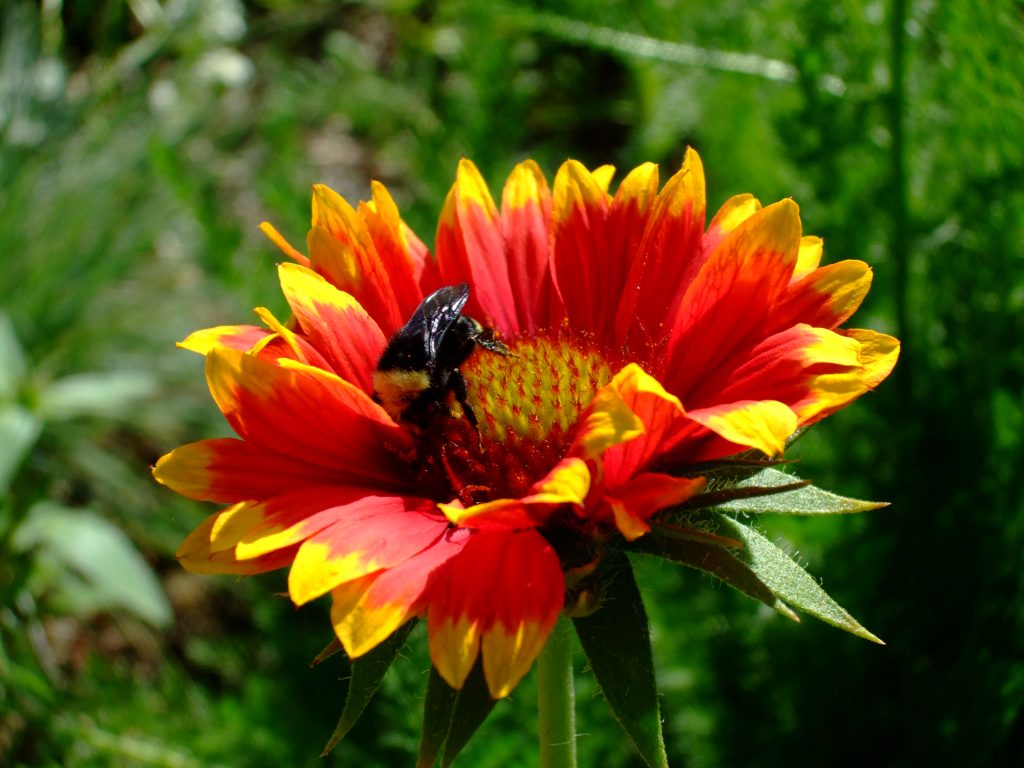
Blanketflower Gaillardia aristata 24-30″ This species is found mostly east of the Cascades in Washington and in the interior northwest states. It is a large composite flower with yellow (often with with red towards the center) ray flowers and reddish brown central disk flowers.
Northern Bedstraw Galium boreale 8-16″ This wildflower has clusters of creamy white flowers on upright stems. Leaves are in whorls of 4. The whole plant is sticky to touch. When dried it has a sweet hay-like scent and has been used since medieval times as a stuffing for mattresses.
Prairie Smoke Geum triflorum 8-20″ This is another wildflower which is more common on the east side of the Cascades. It has interesting magenta-pink nodding flowers. Also known as Old Man’s Whiskers, it gets both its names from its feathery pink/mauve seedheads. A mass of Prairie Smoke creates a pinkish haze across the prairie.
Globe Gilia Gilia capitata 6-36″ Also known as Blue Thimble Flower, this wildflower bears scented, blue flowers in tight balls that look a bit like a pincushion with pins sticking in it. Globe Gilia is a favorite of butterflies & bees.
Prairie Junegrass Koeleria macrantha 8-28″ Not a wildflower, but a lovely, fine-leaved, native tufted bunchgrass. Fresh spring foliage emerges with a touch of blue. Silvery-green airy seed heads form in late spring offering an attractive vertical element to your garden. Bunchgrasses do not spread by runners, they remain in a “bunch.” —drought tolerant once established.
Lewis Flax Linum lewisii 6-36″ This wildflower has blue-green needle-like leaves on graceful stems. Usually sky blue, the attractive flowers can also range from white to yellow to red. Cultivated flax (Linum usitatissimum) is grown both for fiber (flax, linen) and seed oil (linseed).
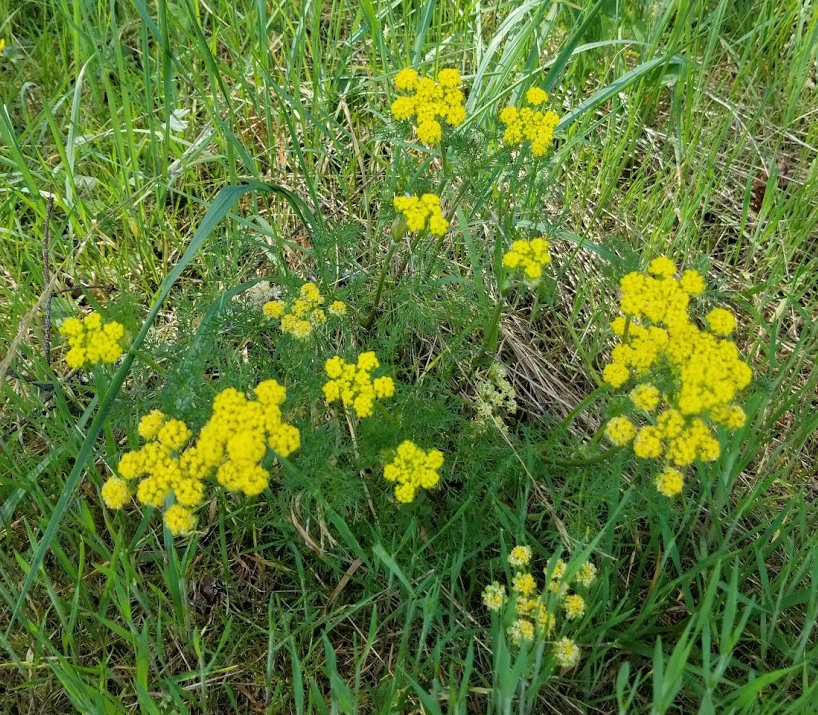
Spring Gold Lomatium utriculatum 6-24″ “Spring gold” is a fitting name for this little wildflower. Brilliant, yellow flowers bloom in spring. Also known as Fine-leaved Desert Parsley, this carrot relative produces flower umbels above a rosette of finely dissected, ferny foliage. It attracts many pollinators and is a host plant for the anise swallowtail butterfly. — drought tolerant once established.
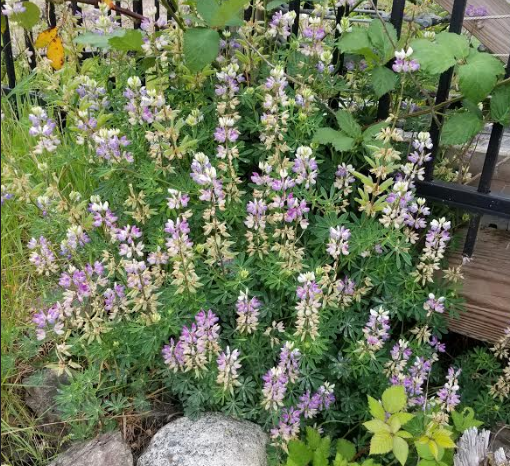
Broadleaf Lupine Lupinus latifolius 2-4′ Classic palmate lupine leaves but with noticeably wider leaflets. It has a bushy, densely branched habit forming multiple flowering stems. Blooms are a lovely, airy lavender-purple on spires up to 10 inches tall. This is a very adaptable lupine for your garden but will appreciate good drainage. Bumblebees love lupines!
Common Evening Primrose Oenothera biennis 12-40″ Evening primrose has attractive pale yellow flowers. The flowers open in the evening and close in the morning. It is a biennial, growing leaves the first year, flowering the 2nd year. Evening primrose attracts bees and different kinds of night butterflies & moths such as hawk moths. Finches eat its seeds.
Slender Cinquefoil Potentilla gracilis 12-24″ This wildflower has palmately divided, 7-9 leaflets, with hairy, silver undersides. Yellow flowers are borne on erect flower stalks. Native bees, butterflies, syrphid flies, and other beneficial insects are attracted to the flowers. It is also a host plant for the caterpillars of butterflies such as the two-banded checkered skipper.
Black-eyed Susan Rudbeckia hirta 24-36″ Also known as Gloriosa Daisy. This sunflower-like flower has large golden, orange or bicolor ray flowers which surround a button of dark chocolate disc flowers. Butterflies of many species are attracted to its bright blooms and birds eat the seeds.
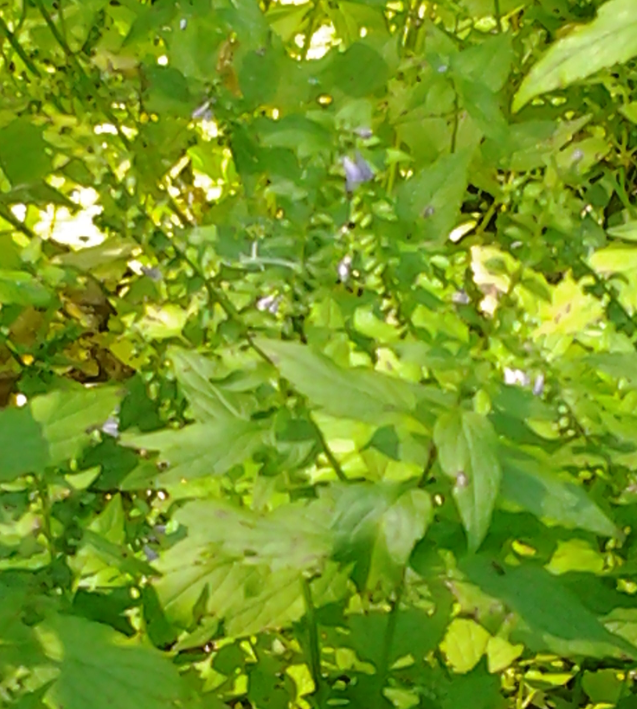
Blue Skullcap Scutellaria laterifolia 24-30″ This wildflower, also known as Mad Dog Skullcap, has tiny snapdragon-like blue flowers on a flower spike. This mint relative grows in wet open woods or meadows, but is not as aggressive as a mint. Its extracts have been used in herbal medicine as a mild sedative and sleep promoter.
Venus Looking Glass Trodanis perfoliata 4-12″ In the Campanula family, this wildflower has violet-blue bell-shaped or more open star-shaped flowers. It is pollinated by small native bees. The seeds of a European species are said to be so shiny that they appeared to be tiny mirrors, or looking glasses, however the seeds of T. perfoliata are too small to appear shiny to the naked eye.
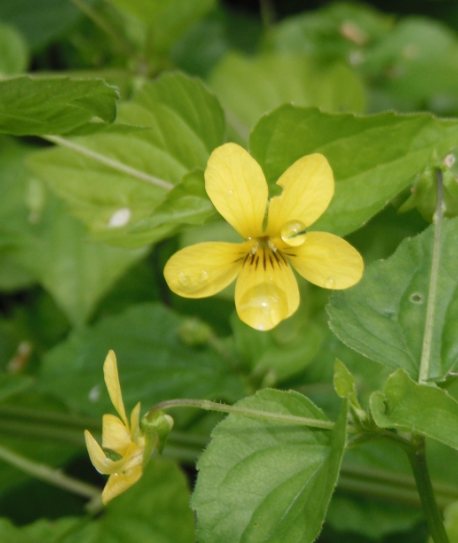
Canary Violet Viola praemorsa 6-10″ This cute little violet is just perfect for the front border of your perennial bed, rock gardens, or along open paths in your woodland garden. It attracts many pollinators. Thick, fuzzy, lance-shaped leaves form a crown that enlarges over time by short rhizomes.
| More information and photos of each of the species may be found where I purchased the seed: Everwilde Farms Willamette Wildings Another source for native wildflower seed is: Northwest Meadowscapes Other good resources: Burke Herbarium Image Collection USDA Plants Database Jepson Eflora E-flora BC Native American Ethnobotany |
